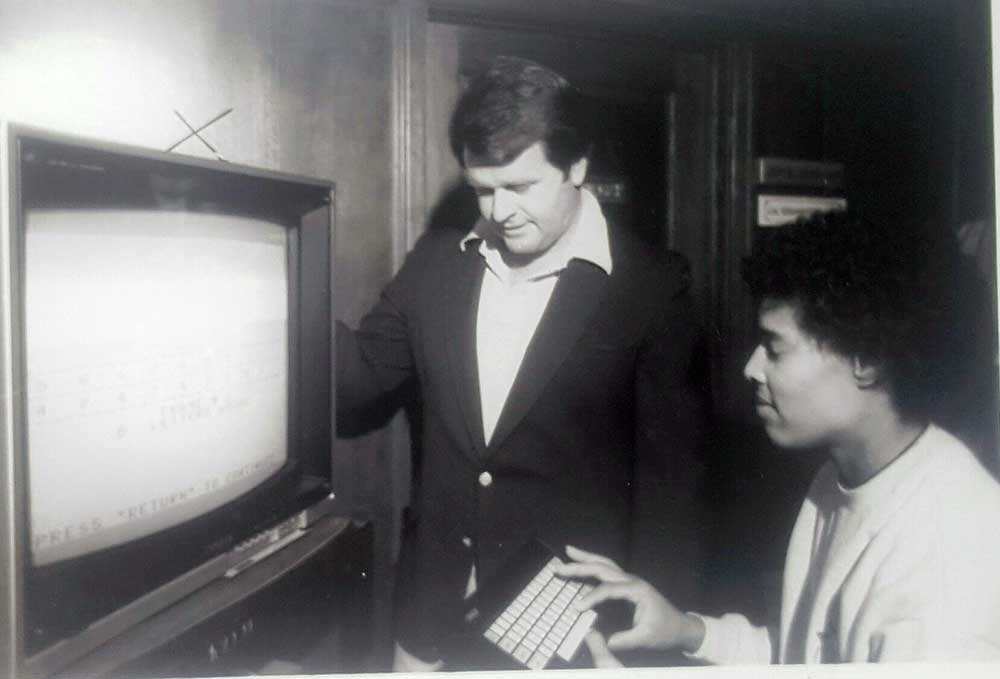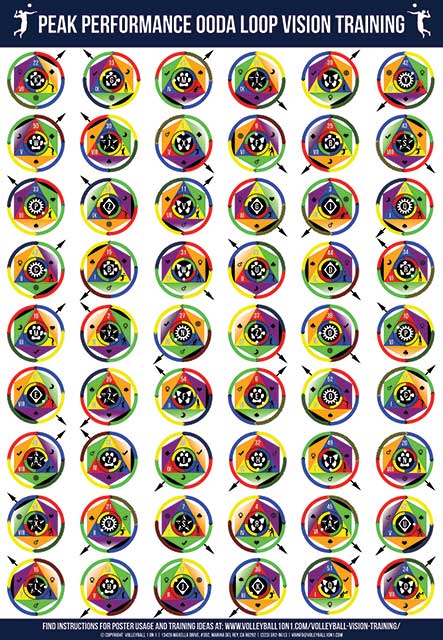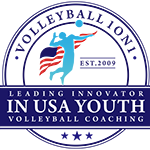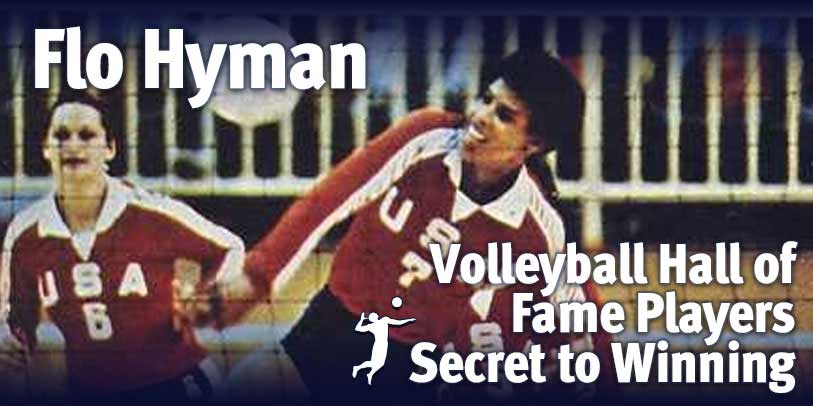Flo Hyman used to be self-conscious about her height. Standing 6 feet tall before she was even a teenager, Hyman did everything in her power to shrink.
And yet, more than half a century later, her name still towers in the world of volleyball.
A three-time All-American and 1984 silver medalist, Hyman was named by Sports Illustrated as one of the greatest female athletes of the century. After an abrupt death at the hands of Marfan Syndrome, Hyman has since been enshrined in the Volleyball Hall of Fame.
Her inscription goes as thus: “It is impossible to quantify the impact Flo Hyman had on the sport of volleyball with just words. She was the most famous volleyball player of the time, not just here in the United States, but also worldwide.”

Dr. Bill Harrison and Flo Hyman doing vision training together
It has been some time since Hyman was dominating on the volleyball court. But one of the major, little known components of her success remains: Dr. Bill Harrison.
Harrison continues to enjoy a worldwide reputation as a longtime vision coach and sports pioneer. He has worked with athletes, coaches and teams across essentially all sports, across essentially all levels – professional, collegiate, amateur, Olympic.
His prolific success with athletes stems from his work in designing and developing a complete training program for the U.S. Olympic Training Centers and the Australian Institute of Sport. He is considered by many to possess one of the finest minds for sports enhancement, as countless world-class athletes go to Harrison in preparation for international competition.
When Harrison and Hyman began working together, they began with the eyes. Vision, he explained, is one of the key concepts athletes need to master. And so began a long-lasting friendship, with Harrison training Hyman in the art of vision, which was the platform upon which she launched her career to becoming the best player in the world at the time.
U.S. Coach Ari Selinger said, “Flo was always a very good player. After getting Dr. Harrison’s training she became number one in the world.”
Harrison now says, “Flo was one of the humblest athlete I have ever worked with. It was as if she had no idea how good she was. She was wanted to learn every way she could to get better so she could help her team.”
In this article, I am going to share many of the key points that Harrison recently shared with me:
- The importance of controlling your eyes: Eyes guide the brain, which guide the body.
- Every play and action should begin and end with what the player sees.
- First and foremost volleyball is a highly visual game.
- Most, all volleyball skills are inherently visual tasks. Few exceptions.
- Visual thinking: Motor patterns are stored in the brain visually. This means that visual thinking can act as a mental rehearsal to performing the physical skill. The famed soccer player Pele used to “warm up” for games by meditating with a towel covering his eyes, imagining a film of highlights in his mind for half an hour before every game. Visual thinking provides players the opportunity to visually anticipate their action, which is more or less a rehearsal for success. We want to teach players to see success prior to them actually achieving it.
- Picture it, focus on it, then perform it.
- The harder you concentrate, the more tension you create. The most effective concentration is effortless, natural.
- Centered / Centering – You cannot cut out info, but you can focus more intently on specific sensory information. Centering is the physical process of tuning into the proper sensory channel, ensuring that you retain maximum information to perform the task at hand. Because it is physical, centering, unlike concentration, can be controlled by practice and repetition.
- You cannot see and hear. You cannot see and think. Our goal is to focus exclusively on vision.
- You are always in control of your centering. There will be distractions; don’t focus on them. Vision directly affects the mental aspect of the game.
- Soft-Centered vs Fine-Centered. In most cases, we are soft-centered. Being fine-centered, however, allows us to slow the ball down and thus slow the game down.
- Small, rhythmical movement in the feet and body can improve vision.
- You only see what you are getting meaning from, Renshaw. (Complementary Video)
Each of these points has enough information to be an article in itself, and over the next few weeks, I will be sharing these ideas in this newsletter and on my website, Volleyball1on1.com.
To read more on this topic: Volleyball1on1 OODA Loop Volleyball Vision Coaching Blueprint and Vision Training for Sports Paper

Peak Performance OODA Loop Vision Training Poster
I am excited to share we have created the Peak Performance OODA Loop Vision Training Poster to help athletes not only improve their ability to “read the game,” they will also learn how to “slow down the ball,” “slow down the game,” and “deal with pressure.” This information works for both indoor and beach volleyball across all skill levels and ages.
The training exercises are broken down into 5 levels as players learn to more effectively move through the OODA Loop while training the 6 muscles that control the eyes.
Level 1 – Involves players “Observing” and “Orientating” information on one or more posters while being static, meaning not moving. (See Training Videos)
Level 2 – Involves players “Observing” and “Orientating” information on one or more posters while being in motion, meaning moving. (See Training Videos)
Level 3 – Involves players “Observing,” “Orientating,” “Deciding” and “Acting” information on one or more posters. Athletes move through all 4 stages of the OODA Loop and need to form “Decisions” and take “Actions” based upon what they “Observed” and the meaning or how they “Orientated” what they observed. (See Training Videos)
Level 4 – Builds on Level 3 meaning players do all 4 stages in level 3 but now also have to track a ball or object that is tossed to them while performing the exercises in Level 3. (See Training Videos)
Level 5 – Build on Level 3 and 4 and includes all parts of 3 and 4, however now players need to also avoid distractions that can include visual, mental, verbal, and other distractions. (See Training Videos)
These posters can be used by elite athletes to help them:
- Control their eyes, which will improve observation, orientation, decision and action.
- This improves the speed that players can navigate through the OODA Loop on the court.
(If you are unfamiliar – Read more on the OODA Loop here).
- Improving each player’s visual speed in the OODA Loop will result in players being able to read the game more efficiently.
- This will also help players slow the ball down, and subsequently slow the game down.
- Improve visual thinking.
- Greater concentration, as well as elongated span of concentration
- Enhanced ability to “center” their focus and thus manage pressure on the court.
- Greater ability to reach the athletic “zone.”
- Improvement in the ability to use the eyes for a fine-centered task for longer periods of time.
- Greater ability to use the eyes while moving or performing tasks.
- Improved peripheral vision
For those who are interested in the topic or would like to learn more about how to use vision as a tool for athletic success, Andor Gyulai and his staff teach a vision clinic at all summer camps as a bonus. Additionally, camps include content on:
- Understanding each skill from “reading the game” and the OODA Loop. Players are taught where to look, when to look, and how to look in a manner that maximizes volleyball actions.
- Players are taught how to slow the ball down, and subsequently slow the game down.
- Players are taught how to improve concentration and focus, reducing mindless errors through the use of vision.
If you would like to learn more about our Volleyball1on1 Camps, or read more into how we offer the best camp on the market, click the links provided. Additionally, schedule a call here if you would like to talk to Andor Gyulai, the owner and founder of Volleyball1on1, personally.







